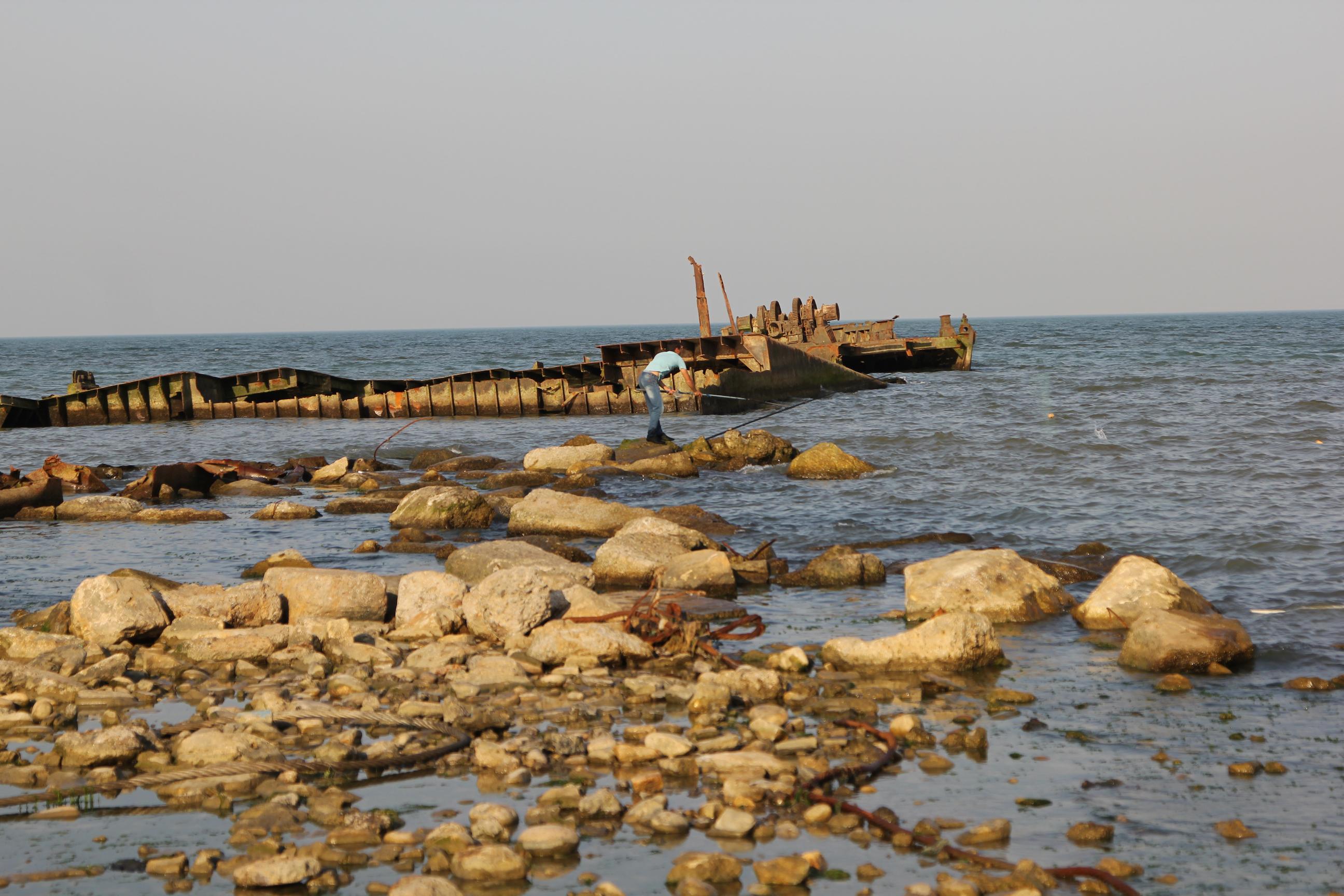Shipping in shallowing Caspian Sea challenges and solutions
The decline in the level of the Caspian Sea, observed since 2005, has greatly accelerated recently.
The most critical situation has been observed in the shallower northern part of the sea, due to which the seaports of Russia and Kazakhstan are faced with big problems with shipping.
Russia and Kazakhstan have begun dredging work in shipping channels and port fairways. Russia has begun this work since 2022 while Kazakhstan last year.
Turkmenistan and Iran, located in the southern part of the sea, suffered less from the shallowing of the sea. The situation in Azerbaijan is relatively stable.
However, dredging work may be in demand in the Dubendi port, as well as in the Alat port in the future.
The construction of a dredger has been underway at the Baku Shipyard since late 2023 to optimize this work.
Numerous environmental problems and pollution of the Caspian Sea are aggravated by the recent rapid shallowing of this sea due to global climatic processes.
The level of the Caspian Sea has decreased by an average of 20 cm per year. Over the past two decades the sea level has decreased by more than 23,000 square kilometres.
Alas, these processes have recently greatly accelerated due to the intensive evaporation of the sea and water does not return naturally through precipitation and river runoff.
Besides global climatic processes and the cyclical nature of the Caspian Sea - the periodic rise and fall of water levels, anthropogenic and technogenic factors have an impact.
The main one is related to the regulation of the bed of the Russian Volga River by hydraulic engineering facilities.
The Volga River provides about 85 per cent of the total water flow into the Caspian Sea, however, back in the Soviet period, nine biggest reservoirs, which were used for agricultural purposes and for water supply, were built on this river.
Droughts of the last decade have increased water intake, which has led to a 25–30 per cent reduction in water flows into the Caspian Sea.
Similar processes associated with excessive irrigation water intake were observed in two other major rivers of the Caspian basin - the Ural River and the Kura River.
Another factor is associated with long-term sedimentation of silt in the delta of the Volga River and the Ural River. This negative feature complicates the flow of water, causes floods (catastrophic flood on the Ural River in April 2024) and greatly reduces the navigability through these rivers.
The most difficult situation in the last period has been observed in the northern, shallowest part of the Caspian Sea.
The Volga-Caspian sea shipping canal practically does not correspond to the rated depths for almost 250 days a year, and ships passing through this section often landed on stranded due to the high siltation of the shallow part of the Volga delta in the Astrakhan region, as well as in the section of the tributary - the Bakhtemir River.
In turn, the shallowing of the Caspian Sea greatly hampered the work of Russian ports in the Astrakhan region.
“Russian President Vladimir Putin instructed the Russian government in December 2022, as part of the work to accelerate the development of the International North-South Transport Corridor, to organise dredging operations in the Volga-Caspian Sea Shipping Canal for ships with a draft of 4.5 metres to be able to pass,” Russian expert, researcher at the Institute of Economics of the Russian Academy of Sciences Alexander Karavaev told Caliber.Az.
“To carry out these operations, numerous dredging fleet was involved, namely, 28 pieces of various equipment, including barges and 12 dredgers of various types. The assigned tasks were generally completed by the end of December last year,” he added.
He noted that these operations improved navigation and increased workload of ships moving along the Volga-Caspian Sea Shipping Canal to the ports of Astrakhan and Olya.

Neighbouring Kazakhstan is also facing similar problems. There was an unprecedented flood on the Ural River and its tributaries flowing into the Caspian Sea in early April 2024.
The water level has risen to 10 metres and two metres above the dangerous level.
“The leadership of Kazakhstan decided to clear the Ural riverbed of silt to a depth of 2.5 metres in connection with the catastrophic spill,” Karavaev said.
“Although these indicators are not designed to sharply increase the navigation rates of this river, they are aimed at facilitating the flow of the spring flood waters and preventing flooding,” he noted.
“This task is extremely important, taking into account that due to siltation, the water level in the Ural River bed has dropped to less than half a metre,” he added.
The river port of the Atyrau city has been idle for three years due to the shallowing of the mouth of the Ural River. Last time big cargo was delivered here in 2020.
To implement dredging work at the mouth of the Ural River, it will be necessary to invest about 16 billion tenge ($36.3 million).
Karavaev said that the shallowing of the Caspian Sea creates even bigger problems for Kazakhstan. The shipping rates of the ports of Aktau and Kuryk have greatly decreased.
Just a year ago the seaports of Aktau and Kuryk had problems while approaching and with depths in the water area.
The depth level averaged 4.9 metres with the standard level of shipping being 6.11 metres. As a result, the loading of ships in Kazakh ports was less than 75 per cent of the available deadweight of ships.
“Oil tankers and dry cargo ships are underloaded in the seaport of Aktau due to the decline in the level of the Caspian Sea,” President of Aktau Sea Trade Port Abay Turikpenbaev said.
“In particular, tankers capable of taking on board 12,000 tons of oil fill only 8,000–8,500 tons, while dry cargo ships underload 300–400 tons from their maximum capacity if they sail to Makhachkala, where the water level is even lower than ours,” he said.
“If tankers sail to Baku, then the loading reaches up to 9,000–9,500 tons,” he added.
Further shallowing of the Caspian Sea will further reduce the loading of tankers, and this will affect the maritime transportation and the cost of transportation will increase.
Kazakhstan plans to spend about 40 billion tenge ($90.8 million) on dredging work to overcome these problems.
Kazakh Prime Minister Alikhan Smailov said that by the end of 2024 the work will be completed in the port of Kuryk, while in 2025 - in the port of Aktau, which will attract large-capacity vessels and expand cargo transportation along the Middle Corridor.
As opposed to its neighbouring countries in the region, the situation with the shallowing of the Caspian Sea in Azerbaijan has not yet created big problems in the main seaports of the country.
Once during the construction of the Baku International Sea Trade Port, large-scale excavation and dredging work was carried out since July 2011. Dutch contractor - Van Oord Dredging and Marine Contractors B.V. was involved.
As a result of using modern equipment and advanced technologies during dredging work, a fairway seven km long, 160 metres wide and 7.6 metres deep was laid in the entrance channel and shunting water area of the offshore part of the port.
The fairway depths are on average within the range of 7.5–6.9 metres thanks to the systematic work to maintain the water area of the Alat port in working condition. Respectively, vessels operating in the Caspian Sea with deep draft can freely moor at the piers of the Baku International Sea Trade Port, which is one of the most modern and deep-water ports of the Caspian Sea.

“All types of vessels may sail due to the current depth in the water area and canal of the port, primarily designed for the transportation of dry cargo,” press secretary of Baku International Sea Trade Port Elmar Gabibli told Caliber.Az.
“Bathometric work is constantly carried out in the Baku port by using the most modern tools, and the area where vessels sail is under constant control,” he added.
In case of a further decrease in the level of the Caspian Sea, there will certainly be a need for additional dredging work.
For this purpose, Baku International Sea Trade Port has already taken proactive measures, acting as a customer of modern dredging equipment.
In particular, the Baku Shipyard and the Dutch Damen Shipyards Gorinchem B.V. signed a contract for the construction of the CSD 650 dredging vessel on October 12, 2023.
The CSD 650 cutter dredger is a 535-tonne vessel with a total length of 61.2 meters, equipped with a 700 kW cutter designed for dredging to a maximum depth of 18 metres.
The vessel is equipped with a refill pump in a separate compartment. The total installed power of this vessel is 2,972 kW, which provides a capacity of about 7,000 cubic metres per hour of soil mixture.
After the construction of the CSD 650 vessel in 2025, its work will be aimed at deepening the fairways in the ports of Azerbaijan to serve ships with a draft of more than 6-8 metres, for example, eight-thousander tankers.
Such modern equipment is extremely important as in case of further shallowing of the Caspian Sea, the process of receiving such vessels be complicated as there is hard clay in the bottom of the Azerbaijani waters of the Caspian Sea, whereas previously there was sand and light clay.
The Azerbaijan Maritime Engineering & Construction LLC (AMEC) is also ready to render support to infrastructure projects within the Trans-Caspian International Transport Route (TITR).
AMEC has a specialized dredging vessel on its balance sheet purchased in 2023, which is currently in the port of Aktau awaiting orders in the Caspian Sea.
In general, the situation with the shallowing of the Caspian Sea currently does not pose big obstacles to the activity of the sea oil terminal in Dubendi and a small dry cargo port with warehouses and 10 berths, which was commissioned in March 2010 in the Zigh area.
However, according to the “Action Plan for 2024–2026 to increase transit potential and encourage transit traffic along transport corridors passing through Azerbaijan” approved by the president in November 2023, the volume of transit cargo traffic through Azerbaijan will have to be increased by 2027 to 13.6 million tons.
The main burden will fall on the Alat port, where large-scale infrastructure work has been underway for several years. A dry cargo terminal has been commissioned, and grain and container terminal facilities are being built.
In the medium term the throughput capacity of the Baku International Sea Trade Port is planned to be increased from the current 15 million tons to 25 million tons per year.
For these purposes, several operations are planned to be carried out to expand the capacity of Azerbaijani sea harbors. The dredging work is planned to be carried out at the ports to prevent the negative impact of the shallowing of the Caspian Sea.








